Common menu bar links
Breadcrumb Trail
ARCHIVED - Canadian Nuclear Safety Commission
 This page has been archived.
This page has been archived.
Archived Content
Information identified as archived on the Web is for reference, research or recordkeeping purposes. It has not been altered or updated after the date of archiving. Web pages that are archived on the Web are not subject to the Government of Canada Web Standards. As per the Communications Policy of the Government of Canada, you can request alternate formats on the "Contact Us" page.
SECTION II - ANALYSIS OF PROGRAM ACTIVITIES BY STRATEGIC OUTCOME
2.1 Strategic Outcome
The Canadian Nuclear Safety Commission has a single strategic outcome: safe and secure nuclear installations and processes used solely for peaceful purposes and public confidence in the nuclear regulatory regime’s effectiveness. To support this outcome, the CNSC has four program activities: regulatory framework; licensing and certification; compliance; and internal services.
CNSC Locations
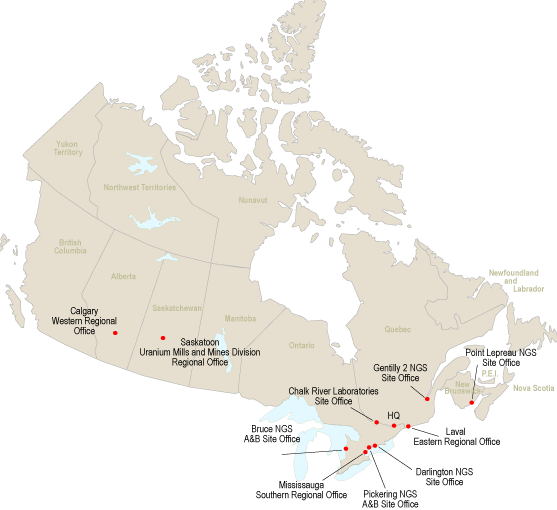
The following section describes the CNSC’s program activities and identifies the expected results, performance indicators and targets for each of them. This section also explains how the CNSC plans on meeting the expected results and presents the financial and non-financial resources that will be dedicated to each activity.
The program activities, their expected results, plans, performance indicators, and planned spending are presented in the following tables in this section.
There are three key priorities that cross-cut the CNSC’s program activities: ensuring the health of Canadians and safety of facilities, implementing a Harmonized Plan, and facilitating the IAEA sponsored Integrated Regulatory Review Service (IRRS) Mission. Each of the CNSC’s program activities contributes to the achievement of these key priorities. The following three priorities support the broader CNSC priority pillar of commitments and ongoing improvements.
Ensuring Health of Canadians and Safety of Facilities
Through inspections, reviews and assessments, the CNSC ensures that the nuclear power industry operates safely and that licensees make adequate provision to protect the environment and the health and safety of persons. The CNSC is also responsible for complying with the Government of Canada’s December 2007 Directive to the CNSC regarding the health of Canadians. This Directive requires that, in regulating the production, possession and use of nuclear substances in order to prevent unreasonable risk to the health of persons, the CNSC takes into account the health of Canadians who, for medical purposes, depend on nuclear substances produced by nuclear reactors.
Ensuring the health of Canadians and safety of facilities is therefore critical. The following activities support the broader CNSC priority pillar of commitments and ongoing improvements:
- Achieve licensing, certification and compliance activity targets set for the period
- Streamline process to review, issue or amend Class 1A operating licences (for example, power reactors)
- Develop a process and performance measurement framework to facilitate continual evaluation of how the CNSC licensing and certification activities contribute to the safety of facilities and the health of Canadians
- Enhance process for evaluating and reporting on licensee compliance and performance
- Review existing limits to determine the acceptance or validation of the regulatory licence discharge limits
- Review and trend power reactor events, inside and outside of Canada, and investigate in Canada where appropriate
- Deploy an effective and comprehensive performance testing program for facility security threat assessment
- Implement an enhanced nuclear emergency management program
- Maintain regulatory oversight of refurbishment projects at Bruce Power’s Bruce A Nuclear Generating Station (units 1 and 2) and New Brunswick Power’s Point Lepreau Nuclear Generating Station
Isotope contingency planning:
- Facilitate efficient regulation of the supply of medical radioisotopes during a future supply crisis
- Review and provide advice on proposals brought forward for the production of medical isotopes including, for example, proposals by McMaster University and UBC/TRIUMF
- Monitor licence conditions for licensees to notify the CNSC of imminent radioisotope shortages
- Continue implementing the protocol for licence renewal of AECL’s NRU facility
- Contribute to domestic and international initiatives regarding the supply of medical radioisotopes
Implementing the Directive on Health of Canadians:
- Incorporate documentation and processes regarding the risk to the health of Canadians into ongoing licensing and compliance operations
Harmonized Plan
The Harmonized Plan of Improvement Initiatives (Harmonized Plan) was initially developed in response to findings and recommendations stemming from the NRU incident in 2007 and the associated Talisman International LLC Lessons Learned report. This plan has evolved to include various internal and external audits and assessments conducted on CNSC processes. It brings together all corporate-wide improvement initiatives under a single umbrella; sets clear deliverables; assigns accountability to ensure that all commitments are met; and helps shift the organization from expert-based regulatory oversight to process-based oversight.
The Harmonized Plan helps identify the commonalities between the different improvement initiatives which will allow for streamlining, prioritizing and allocating resources to maximum efficiency. Management Committee (MC) provides overall direction and leadership to the Harmonized Plan, which is evergreen and refreshed quarterly to ensure it aligns with corporate priorities.
Commitments associated with the Harmonized Plan include:
- Complete the implementation of the Harmonized Plan itself, including validating provisional processes for managing initiatives within the plan; and completing the integration of the Harmonized Plan with the CNSC strategic, business and activity planning processes
- Complete timely and sustainable improvements in the core licensing and compliance processes, including clarifying roles and accountabilities; providing clearer guidance and instruction through improved documentation; and improving consistency in implementation and performance. Targeted process improvements pertain to: commitment tracking, inspections, enforcement, technical assessments, environmental assessments, certification of persons and equipment, and Commission Member Documents (CMDs) preparation
- Increase the organizational capacity for, and competency in, priority setting, risk informed decision making, and project management
- Complete the Integrated Regulatory Review Service peer review against international standards and recognized best practices. The review is to be led by the International Atomic Energy Agency
- Continue the development and implementation of longer term infrastructure-oriented improvement initiatives including: Fee Revenue Management Improvement and the associated CNSC Planning, Management and Reporting System
- Continue ongoing improvements in the Regulatory Framework.
Integrated Regulatory Review Service
The Integrated Regulatory Review Service (IRRS) peer review is one of the services offered to member states by the International Atomic Energy Agency (IAEA). It compares, where possible, a country’s regulatory practices in a country with international standards and equivalent best practices elsewhere. The IRRS peer review is conducted by a team of international experts with direct experience in the areas being evaluated. In late 2005, the CNSC volunteered to receive an IAEA mission. The CNSC has completed the necessary self-assessment and is now preparing for the peer review mission that will occur in the fiscal year 2009-10.
Commitments in support of the IRRS for this planning period include:
- ongoing preparation for the peer review and the hosting of the mission
- an initial response to the IRRS Mission Report highlighting the CNSC strengths and recommendations for improvements
- an approach to addressing recommendations
2.1.1 Program Activity: Regulatory Framework
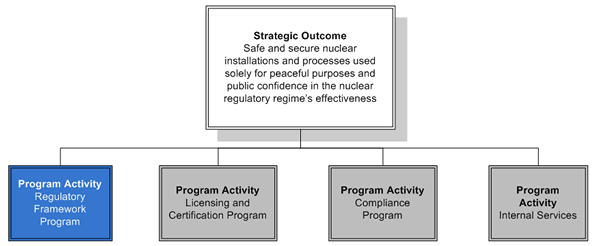
| Program Activity: REGULATORY FRAMEWORK |
|||||
|---|---|---|---|---|---|
| Human Resources (FTEs) and Planned Spending ($ thousands) | |||||
| 2009-10 | 2010-11 | 2011-12 | |||
| FTEs | Planned Spending | FTEs | Planned Spending | FTEs | Planned Spending |
| 149 | $28,761 | 149 | $28,668 | 105 | $21,366* |
| * The CNSC’s regulatory framework program is funded primarily through appropriated funds. In 2011-12 the CNSC’s appropriated funding will be reduced as a result of the completion of two Treasury Board submissions. Additional resources for 2011-12 and beyond will be further considered by the Treasury Board following a policy review by Natural Resources Canada. | |||||
| Expected Result: | A clear and pragmatic regulatory framework | ||||
| Performance Indicators and Targets: |
|
||||
|
Description and Benefits to Canadians: |
The regulatory framework program is in place to ensure that Canadians in general and licensees in particular have a clear and pragmatic regulatory framework for the nuclear industry in Canada. The CNSC’s regulatory framework consists of:
Funds are used to develop the regulatory framework, including the following key activities:
The CNSC also administers the Nuclear Liability Act and, as a responsible authority under the Canadian Environmental Assessment Act, carries out EAs for nuclear projects in accordance with this legislation. |
||||
| Priorities / Key Initiatives and Description of Plans | Timeline for Completion |
|---|---|
| Clarity of our Requirements | |
| Regulatory Framework Priorities | |
Aligning with government-wide regulatory reform initiatives, the CNSC will provide greater clarity for licensees, CNSC staff, the public and other interested persons by:
|
Ongoing |
| Streamline the current document development process to provide more flexibility and timeliness when developing both guidance and regulations. To assist this initiative, the CNSC will be examining the application of information technology solutions to facilitate stakeholder consultation and improve internal processes. | 2009-11 |
| Prioritize review of existing suite of regulations and previously published regulatory documents, to identify and fill potential gaps, to provide the Canadian nuclear industry with timely and needed guidance to address their activities in the years to come. | 2009-10 |
| An early triage of existing regulations has indicated that effort needs to be expanded in the areas of nuclear safeguards and nuclear criticality to determine the most appropriate regulatory tool to communicate the CNSC’s requirements and achieve industry compliance. An examination of the issues surrounding environmental protection will establish if such regulations specific to the nuclear industry are merited. | 2009-10 |
| Execute the IRRS Mission, including its preparatory and follow-up activities. | 2009-10 |
| Initiate policy review of fee-exempt licences. | 2009-12 |
| Undertake analysis and integrate into review of Canadian Environmental Assessment Act. | 2009-10 |
| Major Projects Management Office | |
| The CNSC is a participant in the Government of Canada’s Major Projects Management Office (MPMO). The CNSC fully supports the MPMO’s objectives and goals of improving the federal regulatory system for major natural resource projects. The CNSC will continue to work with its MPMO partners to coordinate regulatory activities related to major nuclear projects, including nuclear power plants, uranium mines and mills, and nuclear waste management facilities; share best practices; undertake and integrate policy review initiatives; and examine administrative, regulatory and legislative options to advance the principles of the MPMO. | Ongoing |
| Communications | |
| Communication/Consultation | |
| Consult with Aboriginal communities (First Nations, Métis, Inuit) regarding the potential impacts of nuclear projects, including nuclear power plants, uranium mines and mills and nuclear waste management facilities, on their Aboriginal rights or title (the duty to consult can be triggered by a variety of CNSC regulatory matters). | 2009-11 |
| Make guidance documents, application forms, and instructions more readily accessible to licensees and other interested persons. | Ongoing |
| Continue to engage international partners and participate in international fora such as the IAEA and the Nuclear Energy Agency to develop and update international standards and best practices. | Ongoing |
| Lead Canada’s delegation to the Joint Convention on the Safety of Spent Fuel Management and on the Safety of Radioactive Waste Management in 2009. | May 2009 |
| Continue to develop bilateral agreements with international partners to share experiences and lessons-learned on design reviews of nuclear power reactor technologies. Canada is a member of the Multinational Design Evaluation Programme (MDEP) which, with the aim of harmonizing regulatory regimes, was established to share resources and knowledge of national nuclear regulatory authorities based on their assessments of new reactor designs. As such, the CNSC will be well-positioned to collaborate with and draw on the experiences of its colleague regulators as it faces the prospect of regulating a nuclear industry that may begin using a variety of new technologies. | Ongoing |
2.1.2 Program Activity: Licensing and Certification
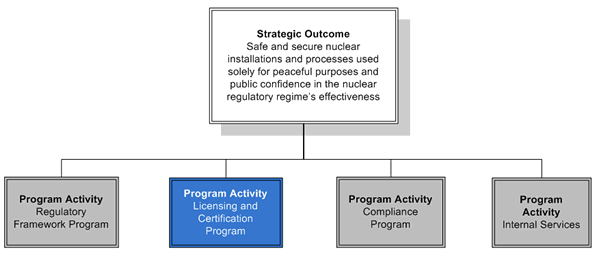
| Program Activity: LICENSING AND CERTIFICATION |
|||||
|---|---|---|---|---|---|
| Human Resources (FTEs) and Planned Spending ($ thousands) | |||||
| 2009-10 | 2010-11 | 2011-12 | |||
| FTEs | Planned Spending | FTEs | Planned Spending | FTEs | Planned Spending |
| 202 | $31,272 | 207 | $32,010 | 200 | $31,912 |
| Expected Result: | Individuals and organizations that operate safely and conform to safeguards and non-proliferation requirements | ||||
| Performance Indicators and Targets: |
|
||||
| Description and Benefits to Canadians: |
The licensing and certification program is in place to issue licences and certify prescribed equipment and certify persons or organizations to conduct nuclear-related activities in Canada. With this program activity’s funding, the CNSC obtains evidence of the applicant or licensee’s ability to operate safely and conform to nuclear safeguards and non-proliferation requirements. The CNSC undertakes this work to ensure that nuclear activities and facilities in Canada are conducted with adequate provision to protect health, safety, and security of persons and the environment, and to fulfill commitments to the peaceful use of nuclear energy. |
||||
| Priorities / Key Initiatives and Description of Plans | Timeline for Completion |
|---|---|
| Clarity of our Requirements | |
| New Build – Execution of Initial Phase | |
|
In addition to the significant licensing workload pertaining to existing facilities, the following new build licence applications are of particular note and focus during the reporting period.
Bruce Power’s Bruce C Nuclear Power Plant in Tiverton (Municipality of Kincardine), ON The project is for the site preparation, construction, operation, decommissioning and abandonment of up to four new nuclear units at the existing Bruce Power site to generate up to 4,000 megawatts of electricity to the Ontario grid. Milestones for the planning period include: |
|
|
Review of Environmental Impact Statement (EIS) and complete application for Licence to Prepare Site, including public review |
May 2009 |
|
Joint Review Panel (JRP) submits Report to Federal Government |
January 2010 |
|
Ontario Power Generation’s Deep Geologic Repository in Tiverton (Municipality of Kincardine), ON The project is for the site preparation, construction and operation of a Deep Geologic Repository (DGR) for the proposed disposal of low- and intermediate-level radioactive wastes at the Bruce Site in Tiverton. The DGR will also hold waste produced from the continued operation of existing Bruce, Pickering and Darlington nuclear generating stations. Milestones for the planning period include: |
Ongoing |
|
EIS guidelines and JRP Agreement published |
2009 |
|
Ontario Power Generation’s Darlington B Nuclear Power Plant in Bowmanville, Municipality of Clarington, ON The project is for the site preparation, construction, operation, decommissioning and abandonment of up to four new nuclear units at the existing Darlington Site to generate up to 4,800 megawatts of electricity to the Ontario grid. Milestones for the planning period include: |
Ongoing |
|
Appointment of JRP |
May 2009 |
|
Review of EIS including public review |
December 2009 |
|
Notice of public hearing |
January 2010 |
|
Bruce Power’s Erie/Nanticoke Nuclear Power Plant in Nanticoke (Haldimand County), ON The project is for the site preparation, construction, operation, decommissioning and abandonment of up to two new nuclear reactors at the Lake Erie Industrial Park, in Nanticoke to generate approximately 2,200 to 3,200 megawatts of electricity to the Ontario grid. The proposed site is located on the north shore of Lake Erie, in the Haldimand-Norfolk region of southern Ontario. Milestones for the planning period include: |
|
|
Draft EIS guidelines and JRP agreement published for comments |
March 2009 |
|
Final EIS guidelines and JRP agreement published |
August 2009 |
|
Appointment of JRP |
September 2009 |
|
Notice of review period on EIS and complete application for licence to prepare site |
October 2009 |
|
Review of EIS and complete application for licence to prepare site, including public review |
October 2009 to April 2010 |
| In addition, the CNSC will undertake preparatory work for potential projects for Bruce Power in Alberta and Saskatchewan and for any new projects in New Brunswick. | Ongoing |
| In addition to the above mentioned new builds, the CNSC will: | |
Complete pre-project design review of AECL’s Advanced CANDU Reactor ACR-1000. The CNSC will issue:
|
2009-10 |
| Continue negotiations with Areva and Westinghouse regarding pre-project design reviews for the AREVA EPR and Westinghouse AP-1000 plants respectively. | 2009-10 |
| Issue guidelines for New Nuclear Power Plant Licence Applications (site preparation, construction and operation). | 2009-10 |
| Ensure assessment plans are developed and published for all current projects undergoing EA and licensing reviews for licence to prepare sites; develop and publish staff review guides for staff reviews of applications for licences to construct; develop and publish assessment plans for all current projects expected to submit applications for licences to construct this fiscal year. | Ongoing |
| Conclude, as part of the Port Hope Area Initiative, the licensing process for the Long-Term Port Hope Waste Management Facility and the EA for the Long-Term Port Granby Waste Management Facility. | 2009-10 |
| Conduct EAs to respond to licence applications for new mines, new reactor construction, refineries, waste repositories and Chalk River Laboratories legacy projects. | 2009-10 |
| Clarify EA regime for uranium mining projects in Nunavut, Labrador and Northern Quebec. | 2009-10 |
| Develop an improved certification process for exposure device operators. | 2009-10 |
| Develop appropriate financial guarantees framework for all regulated activities and facilities. | 2009-10 |
| NRU Licence Renewal | |
|
Continue implementing the protocol for the licence renewal of AECL’s NRU facility. The objective of this protocol is to provide a framework within which AECL and CNSC staff will prepare the necessary information for the Commission to assess the continued operation of the NRU reactor beyond the current licence period which expires in 2011.
Milestones for the planning period include: |
Ongoing |
| As part of the NRU re-licensing process, the CNSC and AECL have agreed to implement an Integrated Safety Review (ISR), which is a comprehensive assessment of plant design, condition, and operation. The ISR will help provide clarity to AECL, the government and all Canadians on the extent, timelines and costs necessary to continue operating the NRU past October 31, 2011. | 2009-11 |
|
June 2009 |
|
January 2010 |
|
November 2010 |
| Clarify approach to safety analysis for non-nuclear power plants; for example, the NRU. | 2009-10 |
| Develop and implement an EA protocol for the NRU licence renewal in 2011. | Ongoing |
| Communications | |
| Implement a protocol for communication and problem resolution with the regulated community across all regulated facilities and activities. | 2009-10 |
| Develop a communications plan for all new major projects. | 2009-10 |
2.1.3 Program Activity: Compliance
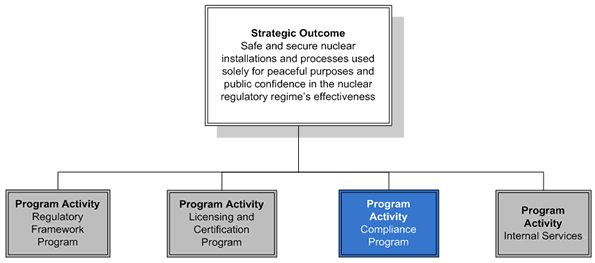
| Program Activity: COMPLIANCE |
|||||
|---|---|---|---|---|---|
| Human Resources (FTEs) and Planned Spending ($ thousands) | |||||
| 2009-10 | 2010-11 | 2011-12 | |||
| FTEs | Planned Spending | FTEs | Planned Spending | FTEs | Planned Spending |
| 255 | $40,605 | 263 | $41,540 | 254 | $41,391 |
| Expected Result: | A high level of compliance by licensees with the regulatory framework | ||||
| Performance Indicators and Targets: |
|
||||
| Description and Benefits to Canadians: | The compliance program is in place to ensure that CNSC licensees exhibit a high level of compliance with the CNSC’s regulatory framework. This program enables the CNSC to provide regulatory assurance to Canadians of the continuing compliance and safety performance of licensees. This program activity’s funding is used for the promotion of compliance, safety culture and common safety values, compliance audits, inspections, and enforcement actions. | ||||
| Priorities / Key Initiatives and Description of Plans | Timeline for Completion |
|---|---|
| Clarity of our Requirements | |
| Compliance Framework | |
| Implement a new approach for mid-term status reports wherein certain licensees will have a greater role in reporting information, to be complemented by CNSC staff who will report on compliance and inspection findings. | Ongoing |
| Develop strategies to promote/enforce compliance where licensee deficiencies have been identified and respond to risk significant licensee reports and findings. | 2009 |
| Revise approach with carriers with respect to radiation protection program (linked to Packaging and Transport of Nuclear Substances Regulations amendments). | 2009 |
| Improve the process and documentation for Type I and II Inspections (for example, checklists, inspection reports). | Ongoing |
| Implement enhanced radiography strategy to regulate the radiography industry. | Ongoing |
| Develop an inspection/monitoring approach for new major facilities. | 2009-10 |
| Coordinate and develop compliance programs for licenses for new mines and licences for new nuclear power plants. | 2010-11 |
| Communications | |
| Communication with our Licensees | |
| Develop an online system for receiving compliance reports from licensees. | 2009-10 |
| Develop and implement a program for risk-informed event oversight and follow-up for unplanned events and incidents that are reported. This oversight program will include events and incidents reported via licensees as well as non-licensees. The objective is to ensure that all unplanned events and incidents reported are responded to and followed up uniformly and consistently. | 2009-10 |
| Our Daily Activities |
|---|
|
The majority of the CNSC’s work involves undertaking licensing and compliance activities in a risk-informed fashion to ensure that licensees meet regulatory requirements set out in their licences. This requires maintaining an adequate level of regulatory vigilance, and being prepared to react based on credible information received. Much of the compliance work is in the form of inspections of varying types. A Type I inspection is a systematic and documented process to determine, through objective evidence, whether a licensee program, process or practice complies with regulatory requirements; these inspections are similar to an audit or program evaluation. Type II inspections are planned and documented activities to verify the results of licensee processes and not the processes themselves. They are typically routine (item-by-item) inspections and rounds, usually of specified equipment, facility material systems, or of discrete records, products or outputs from licensee processes. A Desktop Review is the CNSC staff analysis of compliance reports submitted by licensees to evaluate if the licensee is complying with the requirements of the regulatory framework. Typically, in a fiscal year, the CNSC will undertake approximately 100 Type I inspections, 1500 Type II inspections and countless desktop reviews. |
2.1.4 Program Activity: Internal Services
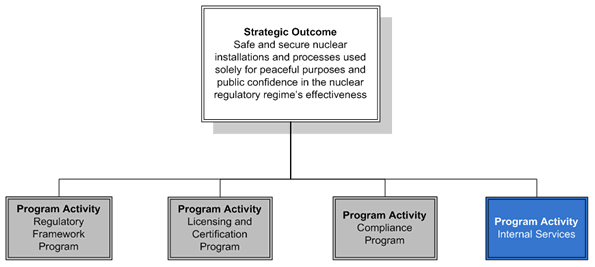
| Program Activity: INTERNAL SERVICES |
|||||
|---|---|---|---|---|---|
| Human Resources (FTEs) and Planned Spending ($ thousands) | |||||
| 2009-10 | 2010-11 | 2011-12 | |||
| FTEs | Planned Spending | FTEs | Planned Spending | FTEs | Planned Spending |
| 234 | $42,093 | 241 | $42,764 | 216 | $39,802 |
| Description: | Internal services are activities and resources to enable and support program delivery and meet other corporate obligations of the Commission as an agency of government. These activities are: Management and Oversight (Audits, Evaluations and Ethics); Communications; Legal Services; Human Resources Management; Financial Management; Information Management; Information Technology; Real Property and Materiel Acquisition; Travel and Other Administrative Services. Internal Services include only those activities and resources that apply across the organization and not to those provided specifically to a given program. | ||||
| Priorities / Key Initiatives and Description of Plans | Timeline for Completion |
|---|---|
| Capacity for Action | |
| Revenue Spending | |
| Streamline and simplify the current business processes and coding practices and increase investments in financial systems infrastructure to support planning, tracking, cost recovery billing and revenue management to ensure effective transition to the full RSA funding regime. | 2009-11 |
| CNSC Renewal | |
| The CNSC will continue to support the Public Service renewal initiatives, with focus on improved planning, targeted recruitment, employee training/development and specific infrastructure and policy improvements. | |
|
2009-10 |
|
2009-10 |
|
2009-10 |
| Information Management/Infrastructure | |
|
A number of investments in information management and information technology (IM/IT) are being made in order to support the CNSC’s goals to be more efficient, strengthen regulatory commitment tracking activities and improve communications. These goals necessitate a robust electronic information management framework that will ensure the continued good
management of our information assets. Specifically, IM/IT investments will support the following business drivers:
These investments include: |
|
|
2009-10 |
|
2009 |
|
2009-10 |
|
2009-10 |
|
2009 |
| The CNSC will continue in 2009-10 to relocate staff to a second location to accommodate growth and will initiate the process of renewing its office leases in the National Capital Region. | 2009-13 |
| Service Improvements | |
|
The CNSC will review and institute specific internal service improvements to enhance delivery to program managers. Improve access and content of Web-based corporate polices/procedures and institute appropriate service standards for these services.
|
2009-12 |
| Another key initiative will be to implement, by April 1, 2009, of a new Audit Committee that will comprise two internal and three external members. This will bring increased accountability and is in line with the Office of the Comptroller General guidelines. | 2009 |
| Communications | |
| Increased Awareness | |
| Plan and implement the next phase of the CNSC’s external Web site restructuring to include more business functionality. | 2009 |
